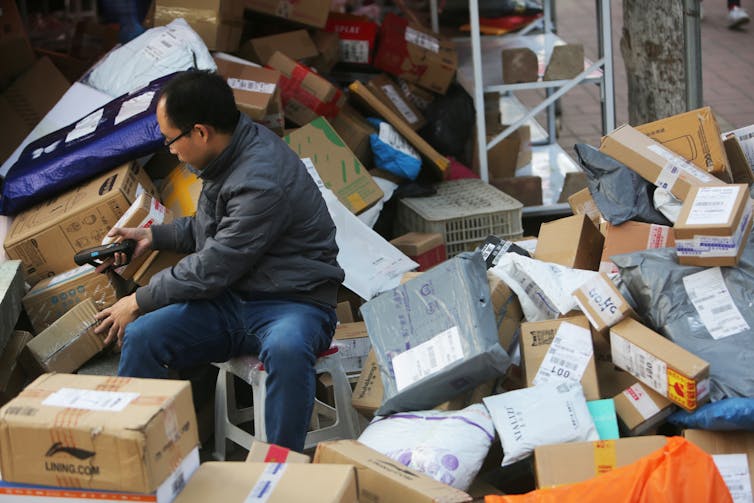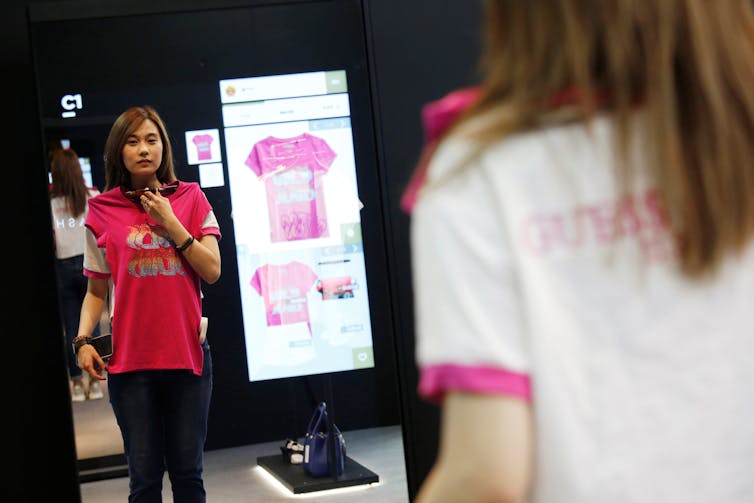Singles Day shows China's global retail power
- Written by Venkatesh Shankar, Professor of Marketing; Director of Research, Center for Retailing Studies, Texas A&M University
Nov. 11, or 11/11, has been celebrated as Singles Day – a sort of anti-Valentine’s Day[1] for single people – since 1993. Chosen because its date has four ones in a row, the holiday originated in China and has become the largest shopping day of the year, in both online and offline retail sales around the world. It’s a signal of shifting power in the global retail sales market, moving away from the U.S. and toward Asia – specifically China.
Alibaba, the giant Chinese e-retailer that promoted the day as an opportunity – or excuse – for single people to treat themselves with new purchases, has seen its revenues on Nov. 11 grow from US$100 million in 2009[2] to 250 times that in 2017, $25 billion[3]. And that was only two-thirds of total online sales[4] that day.
Singles Day dwarfs the three other largest online retail mega-events. In 2017, Thanksgiving weekend online sales – including Black Friday[5] and Cyber Monday[6] – totaled $7.3 billion. The third, Amazon’s Prime Day, in 2017 took in $100 million an hour[7] – but Alibaba raked in 10 times that amount[8] on Singles Day that year.
Getting in on the action
By 2022, Chinese middle-class shoppers as a group are projected to both outnumber and outspend U.S. customers[9]. Retailers around the world are seeking to take advantage of this growing Chinese economic power, offering their own Singles Day deals and even seeking to expand the day into a longer festival: Alibaba is keeping its discounts going for 48 hours, and its main Chinese competitor, JD.com, began an 11-day festival from Nov. 1 to Nov. 11 with a set of limited-time discounts that grossed $865 million in its first hour[10].
Global brands like Adidas, Mattel, Mondelez, Nike and Unilever[11] participated in 2017 by offering deals on a variety of their products. JD.com teamed up with Tencent[12] – another Chinese e-commerce behemoth – and Walmart to offer one another’s customers the same special deals on Singles Day 2017. In 2018, Alibaba subsidiary Lazada is offering Singles Day sales in six Southeast Asian countries[13].
 A mountain of packages waits to be delivered at Shandong University in eastern China after Singles Day 2017.
China Stringer Network/Reuters[14]
A mountain of packages waits to be delivered at Shandong University in eastern China after Singles Day 2017.
China Stringer Network/Reuters[14]
Online or in store?
For 2018, Alibaba is promising special discounts on 1.5 million products[15] in 3,700 categories, from 180,000 brands from China and 74 other countries. The company plans to fulfill much of the enormous order volume from its robot-automated warehouse[16] where 700 robots will automatically pick up items and assemble packages for shipping to customers.
Many companies are working to develop their electronic customer base, particularly with mobile apps[17]. But there is still big money in the real world.
Though landmark retailers like Sears[18] and J.C. Penney are struggling in the U.S., the vast majority of global shopping is still done in-person[19], rather than online. Newer mega-retailers like Walmart, Target and Best Buy[20] are thriving in the U.S. and elsewhere. Even pure e-commerce retailers such as Amazon are moving offline, opening cashierless Amazon Go stores[21] and physical bookstores, buying Whole Foods[22], and partnering with Kohl’s to handle product returns.
In China, Alibaba has moved into physical stores, too, acquiring the InTime department store and mall chain[23] and opening 60 Hema supermarkets[24] that don’t accept cash and where customers’ food purchases can be prepared before they check out. The company has also set up 100,000 convenience stores[25] as places where customers can try on products in augmented reality and pay with facial recognition systems.
 In Alibaba ‘smart centers,’ customers can see how items would look on them, and find out other details about materials and prices on mirrored screens.
REUTERS/Bobby Yip[26]
In Alibaba ‘smart centers,’ customers can see how items would look on them, and find out other details about materials and prices on mirrored screens.
REUTERS/Bobby Yip[26]
The future of retail
Shoppers around the world want to be able to buy both online and in physical space, from any device and by any payment method – all while getting a high level of customization and service experience. This goes beyond the simple mechanics of telling a smart speaker like Amazon Echo, Google Home or Apple’s HomePod to order more laundry detergent.
Artificial intelligence systems are analyzing customers’ behavior, which can make routine shopping for items like facial tissues and soap faster and easier, by remembering what brands a customer likes, and how often to order refills. AI can also suggest products customers might want to buy, based on their previous purchases – as Amazon already does[27]. That can make shopping for luxury products, splurges and gifts more fun and engaging.
The global retail market is adjusting to China’s rising economic power, and Chinese customers’ desire for AI-enhanced mobile shopping experiences. Singles Day’s spread across the world suggests a new chapter of computer-enhanced shopping experiences is beginning.
References
- ^ anti-Valentine’s Day (en.wikipedia.org)
- ^ US$100 million in 2009 (www.theatlas.com)
- ^ $25 billion (www.statista.com)
- ^ two-thirds of total online sales (www.digitalcommerce360.com)
- ^ including Black Friday (www.statista.com)
- ^ Cyber Monday (www.statista.com)
- ^ $100 million an hour (www.statista.com)
- ^ 10 times that amount (www.statista.com)
- ^ both outnumber and outspend U.S. customers (www.businessinsider.com)
- ^ grossed $865 million in its first hour (technode.com)
- ^ Adidas, Mattel, Mondelez, Nike and Unilever (www.adweek.com)
- ^ JD.com teamed up with Tencent (www.fool.com)
- ^ in six Southeast Asian countries (econsultancy.com)
- ^ China Stringer Network/Reuters (pictures.reuters.com)
- ^ special discounts on 1.5 million products (www.businessinsider.com)
- ^ robot-automated warehouse (www.cnbc.com)
- ^ particularly with mobile apps (theconversation.com)
- ^ landmark retailers like Sears (theconversation.com)
- ^ done in-person (theconversation.com)
- ^ mega-retailers like Walmart, Target and Best Buy (multichannelmerchant.com)
- ^ cashierless Amazon Go stores (www.businessinsider.com)
- ^ buying Whole Foods (theconversation.com)
- ^ acquiring the InTime department store and mall chain (www.forbes.com)
- ^ opening 60 Hema supermarkets (www.businessinsider.com)
- ^ set up 100,000 convenience stores (technode.com)
- ^ REUTERS/Bobby Yip (pictures.reuters.com)
- ^ Amazon already does (www.wired.com)
Authors: Venkatesh Shankar, Professor of Marketing; Director of Research, Center for Retailing Studies, Texas A&M University
Read more http://theconversation.com/singles-day-shows-chinas-global-retail-power-103125

